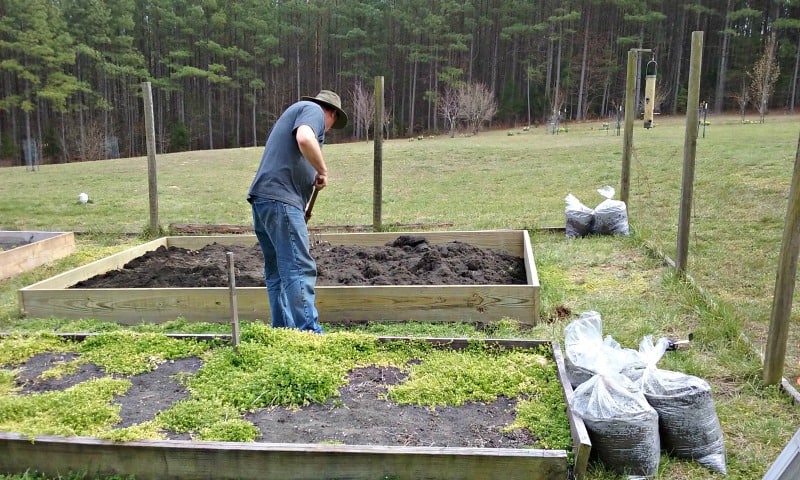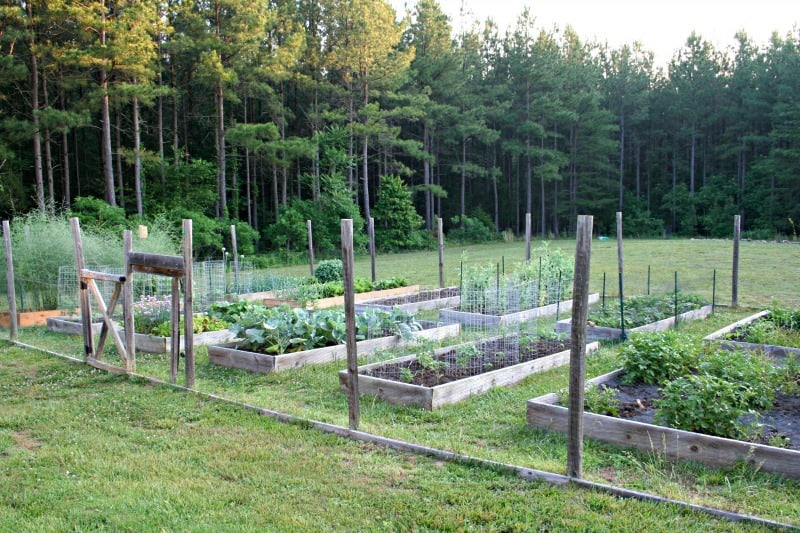Is it safe to use pressure-treated lumber in the vegetable garden? Pressure-treated lumber resists rot and insect damage. But are the chemicals used to treat the lumber safe to use when growing food for yourself and your family?
Pressure Treated Lumber: Is It OK to Use in the Garden?
Pressure-treated lumber sold in stores today differs from what was sold many years ago. Older methods of treating wood utilized an arsenic derivative to discourage insect damage.
In 2002, the Environmental Protection Agency worked to outlaw the use of chromate copper arsenate (CCA) from lumber for home use. CCA offered several benefits, including greater protection against insect damage, but a significant drawback: it leached arsenic into the soil.
Arsenic, as you probably know, is poisonous. It does not hurt you in small amounts, and you probably have some in your body now just from eating conventional produce. It can, however, build up over time into amounts significant enough to cause health problems.
When CCA-treated lumber touches the soil and water drenches the wood, over time, the compound breaks down and leaches, or drips, into the soil. Plants take up nutrients through their root system. The water they drink through their roots contains minerals and nutrients. It may also include some of that arsenic if CCA lumber is used.
CCA Outlawed in 2003
The American government outlawed CCA in 2003. Companies today utilize alkaline copper quaternary (ACQ) as a replacement for CCA. Is ACQ totally safe? There’s no consensus on its safety record, and aside from manufacturers’ tests, little has been done to truly ascertain its safety.

Do the Chemicals Get Into the Soil?
I’ll link to the scientific research at the end of this article, but here’s the gist of the results from CCA-treated lumber (remember, it’s outlawed, but the amounts found in plants may be comparable, more or less, to ACQ. That assertion is not backed up by research but my own extrapolation of the data.)
Study Results
There have been some limited studies on garden plants to see how much CCA or ACQ actually gets into vegetables intended for consumption.
- Arsenic, copper, and chromium levels found in the vegetables grown in raised beds made from pressure-treated wood were the same as conventionally grown vegetables purchased from a grocery store.
- Romaine lettuce grown in pots with soil in which small amounts of compounds such as arsenic were also tested to see how much of the chemical would be absorbed by the plant. The Romaine lettuce absorbed some. In a 50 gram serving (considered a normal serving of lettuce for an adult), 0.004 mg of As was found. The estimated safe level of arsenic is 0.05. You would have to eat 1.3 pounds of the lettuce in the experiment EVERY DAY to exceed the safety limit.
- The closer vegetables are grown to the wood, the more chemicals they absorb. Plants growing about six inches away from pressure-treated wood do not show even trace amounts of chemicals.
- Root crops such as beets, turnips, carrots, and potatoes contained most of the metals they absorbed in the skin. Therefore, peeling removes most of it.
- Plant species differ greatly in the number of metals they take up from the same soil. This is due to the difference in the movement of fluids inside the plant itself. Most metals remain in the roots with the exception of leafy green vegetables. Lettuce, spinach, and mustard greens tend to move metals into the leaves.
The Bottom Line: You Can Use Treated Lumber for Raised Bed Gardens
Scientific evidence backs up the claim that it is fine to use modern treated lumber in raised bed gardens.
Here’s how I look at it: there are risks from all of the food we consume. I think nothing of eating conventional products and packaged foods.
If they are getting any chemicals from the ACQ treated lumber (the beds were built after 2009, well after the time frame in which the EPA required companies to phase out the use of CCA-treated lumber), the trace amounts should be so minor that it won’t make much of a difference to me.

Alternatives to Pressure-Treated Lumber
There are some loyal readers of this website and blog who say to themselves, “Well, that’s fine for you, Jeanne, but I won’t use any pressure-treated wood in my garden, period!” If you really don’t want ANY chemicals from the soil, you do have options to build your raised beds for a vegetable garden.
Optional materials to build raised beds include:
- Untreated lumber. It’s going to break down faster than treated, but it’s inexpensive and easy to work with. Pine is inexpensive, easy to cut, and readily available.
- Cedar: A natural product and also wood, so it’s easy to work with. Cedar is naturally rot resistant. It can be expensive.
- Stone: You can stack landscape stones or bricks to make a raised bed.
Never Use These Materials to Build a Raised Bed Garden for Edibles
What you should NEVER use for a raised bed:
- Old tires. I go a little crazy when I see all those Pinterest pins of recycling big truck tires into raised beds. Sure, they’re fine for flowers. Have fun with flower planters. You don’t eat flowers. But for vegetables, fruit and herbs, avoid tire gardens at all costs.
Tires pick up all sorts of crud from the road. Oil, gasoline, road salts…I’m gagging just thinking of the chemicals that are inside those tires. When you pour soil inside and water your plants, guess what? They leach out of the tires, too, and if you’re trying to grow lettuce, that Romaine lettuce is going to suck up the minerals as well as the chemicals. And you’re going to eat the lettuce and basically eat recycles oil, gasoline, and road salts (more or less). No thank you.
Raised Bed Vegetable Gardening Research
I hope that this has helped clear up some of the confusion around using pressure treated lumber in a raised bed garden. Here is the research I’ve read to write this article. Feel free to link to it or to share it with friends.
- National Pesticide Information Center
- Oregon State University Extension Service
- Pennsylvania State University Research and Extension Office (PDF download)





Good to know for someday when I get a chance to build some raised garden beds again!
I have been wanting to make some garden boxes for my apartment, but I didn’t know if I could use treated lumber for my boxes. That is good to know that the closer the plants are to the wood the more chemicals are absorbed. I’m glad that the bottom line is it is ok to use treated lumber because only a small amount of chemicals can be absorbed into the plants. Thank you for the information!
Jeanne,
I have made contact with the mushroom compost guy! Thanks. I have a question: I am weeding out vinca on a huge bed and want to put in 2-3 raised beds or directly sow and want to know if it’s better to amend now (totally depleted and clay) or wait until Spring? If wait, should I plant a cover crop, use straw, or leave it?
Hi Tamara! Really, the choices is yours to put the soil in now or wait. If you do put the soil in now, you run the risk of growing a weed crop (my favorite winter activity). Cover crops are fine and can be used to amend the soil. I usually do bed repair on the wooden frames now and over the winter, then amend the soil in March before spring planting. Hope this helped and thanks for leaving a comment!
YES! on the tire planters for food comment. I am also nervous when I see pallets re-used for food planters. You have no idea what material was shipped on them and what may have leaked on them. Use them for flowers, maybe, but not food.
Thanks for the advice, my wife was considering using pressurized lumber for our landscaping and her garden. It is nice to know that there are really no chemical hazards for using this kind of wood. Although, it is surprising to still read how many chemicals can get inside of certain vegetables.